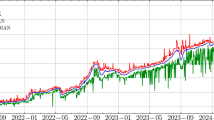Abstract
Rising housing prices are accompanied by higher household consumption and firm investment that boost economic growth. However, excessive house price appreciations may distort capital allocation efficiency, for example by crowding out investments in productive sectors, which reduce long-term economic growth. Moreover, house price bubbles are typically unsustainable. Once a housing bubble bursts, credit conditions will tighten due to falling collateral value, leading to a fall in household consumption and employment that cause an economic downturn. Meanwhile, the correction of housing prices may improve investment efficiency and trigger structural reform that subsequently enhances economic growth. We look into the trade-off between the aforementioned effects at different stages of housing cycles and economic growth. Using a quarterly dataset that covers cross-country house prices over four decades, we find that house price appreciations are positively associated with economic growth, while the relationship between house price depreciations and economic growth is highly non-linear, depending on country-specific characteristics. In the absence of confounding crisis in the financial sector, short-lived large house price depreciations, rather than prolonged and modest ones, are positively associated with economic growth. The association between house price depreciations and economic growth is subject to legal systems, mortgage insurance, and personal bankruptcy law.


Similar content being viewed by others
Notes
The data is available from http://www.economist.com/blogs/dailychart/2011/11/global-house-prices. The original data covers 21 countries, Singapore and China are excluded from the final sample due to the lack of quarterly data on trade and inflation in International Financial Statistics.
It is calculated as [17%*2.07*6 + 11%*(5.06–2.07) *5]/100 = 3.76%, where 2.07 is the estimated coefficient of HPR and 5.06 is the estimated coefficient of |HPR|*DHPR < m in Table 3. The difference between 5.06 and 2.07 measures the relation between large depreciations and economic growth. More precise calculations that simulate the growth of housing prices and its cumulative association with growth yield similar results. For example, the compounded cumulative return is (1 + 17%*2.07/100)6*(1 + 11%*(5.06–2.07)/100)5–1 = 3.82%.
References
Acemoglu D, Carvalho VM, Ozdaglar A, Tahbaz‐Salehi A (2012) The network origins of aggregate fluctuations. Econometrica 80(5):1977–2016
Aizenman J, Jinjarak Y (2009) Current account patterns and national real estate markets. J Urban Econ 66(2):75–89
Aizenman J, Jinjarak Y (2014) Real estate valuation, current account and credit growth patterns, before and after the 2008–9 crisis. J Int Money Financ 48:249–270
Alfaro L, Chanda A, Kalemli-Ozcan S, Sayek S (2004) FDI and economic growth: the role of local financial markets. J Int Econ 64(1):89–112
Almeida H, Campello M, Liu C (2006) The financial accelerator: evidence from international housing markets. Review of Finance 10:321–352
Beltratti A, Morana C (2010) International house prices and macroeconomic fluctuations. J Bank Financ 34(3):533–545
Borensztein E, Lee J-W (2002) Financial crisis and credit crunch in Korea: evidence from firm-level data. J Monet Econ 49:853–875
Borio, C., Disyatat, P., Juselius, M., (2015). "Rethinking potential output: embedding information about the financial cycle." PIER Discussion Paper, Bank of Thailand
Bracke P (2013) How long do housing cycles last? A duration analysis for 19 Oecd countries. J Hous Econ 22(3):213–230
Caballero RJ, Hoshi T, Anil K (2008) Zombie lending and depressed restructuring in Japan. The American Economic Review 98.5:1943–1977
Chakraborty I, Goldstein I, MacKinlay A (2018) Housing price booms and crowding-out effects in bank lending. The Review of Financial Studies 31(7):2806–2853
Chaney T, Sraer D, Thesmar D (2012) The collateral channel: How real estate shocks affect corporate investment. American Economic Review 102(6):2381–2409
Conley TG, Hansen CB, Rossi PE (2012) Plausibly exogenous. Rev Econ Stat 94(1):260–272
Donovan, Colleen and Calvin Schnure. (2011). "Locked in the house: do underwater mortgages reduce labor market mobility?" https://doi.org/10.2139/ssrn.1856073
Jordà, Ò., Schularick, M., and Taylor, A. M. (2015a). "Leveraged Bubbles," National Bureau of Economic Research Working Paper Series, No. 21486
Jordà Ò, Schularick M, Taylor AM (2015b) "betting the house." journal of international economics 96. Supplement 1:S2–S18
Laeven L, Valencia F (2013) Systemic banking crises database. IMF Economic Review 61(2):225–270
Lau LJ, Zheng H (2015) How much slack was there in the Chinese economy prior to its economic reform of 1978? IGEF Working Paper (34)
Mian A, Sufi A (2014) What explains the 2007–2009 drop in employment?. Econometrica 82(6):2197–2223
Mian A, Rao K, Sufi A (2013) Household balance sheets, consumption, and the economic slump. The Quarterly Journal of Economics 128(4):1687–1726
Mian A, Sufi A, Trebbi F (2015) Foreclosures, house prices, and the real economy. J Financ 70(6):2587–2634
Miller N, Peng L, Sklarz M (2011) House prices and economic growth. The Journal of Real Estate Finance and Economics 42(4):522–541
Miao J, Wang P, Zhou J (2015) Asset bubbles, collateral, and policy analysis. Journal of Monetary Economics, 76:S57–S70
Musso A, Neri S, Stracca L (2011) Housing, consumption and monetary policy: how different are the us and the euro area? J Bank Financ 35(11):3019–3041
Porta RL, Lopez-de-Silanes F, Shleifer A, Vishny R w (1998) Law and finance. J Polit Econ 106(6):1113–1155
Schulhofer-Wohl S (2011) Negative equity does not reduce Homeowners' mobility. National Bureau of Economic Research Working Paper Series (16701)
Shim I, Bogdanova B, Shek J, Subelyte A (2013) Database for policy actions on housing markets. In: BIS quarterly review : international banking and financial market developments, pp 83–95
Yanikkaya H (2003) Trade openness and economic growth: a cross-country empirical investigation. J Dev Econ 72(1):57–89
Author information
Authors and Affiliations
Corresponding author
Additional information
Publisher’s Note
Springer Nature remains neutral with regard to jurisdictional claims in published maps and institutional affiliations.
Appendix
Appendix
Rights and permissions
About this article
Cite this article
Aizenman, J., Jinjarak, Y. & Zheng, H. Housing Bubbles, Economic Growth, and Institutions. Open Econ Rev 30, 655–674 (2019). https://doi.org/10.1007/s11079-019-09535-9
Published:
Issue Date:
DOI: https://doi.org/10.1007/s11079-019-09535-9




